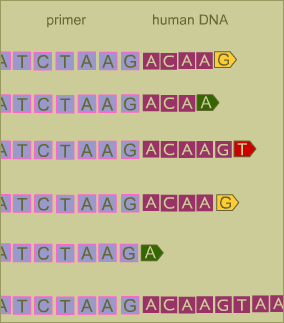
|

|
Sequence for Yourself
Part IV: Detecting the Sequence
previous |
next
 Add DNA to Capillary
Add DNA to Capillary
So now we have billions of copies of a unique DNA strand,
of various lengths, and each marked with a color. To get
the sequence of A's, G's, C's, and T's, all we need to do
is sort the strands according to length, then read the
color of the bases of the pieces that are the same length
to determine the last base for that length.
We place our latest batch of DNA at one end of a capillary
-- a thin plastic tube -- that is filled with a gel.
 Initiate Electrophoresis
Initiate Electrophoresis
We apply an electric field to the gel -- positive at one end
and negative at the other. This causes the negatively
charged DNA pieces to migrate to the positive end.
Because of the gel's resistance, the smaller pieces of DNA
travel faster through the gel than do the larger pieces. The
movement of the pieces is very precise: For example, a piece
that is 396 base pairs long will move ever so slightly
faster than a piece that is 397 base pairs long.
 Detection
Detection
As the DNA pieces move past the machine's detector, a laser
causes the marker on the special nucleotide to fluoresce.
There will be many copies of a DNA fragment of the exact
same length passing the detector at the same time.
The combination of all of their tags will produce a reaction
to the laser that is intense enough for the detector to
read.
 Data Collection
Data Collection
The greens, yellows, blues, and reds scanned by the detector
are sent to a computer, which converts the colors into A's,
G's, C's, and T's. Because the sequence of the primer is
known, the computer can determine the first base of the
cloned DNA strand and then the subsequent 500 bases.
Shown here are only a few strands worth of data. Keep in
mind that the lengths of many strands are much longer and
that there are perhaps thousands of copies for each specific
length.
 Determine Sequence of 500 bp Reading
Determine Sequence of 500 bp Reading
With information about both the lengths of the DNA strands
and the strands' final bases, the computer can easily
determine the sequence of the strand.
Next, we need to piece together 500 bp sections to
reconstruct the 2,000 to 4,000 bp fragment.
Continue: Part V: Assembly and Finishing
Watch the Program Here
|
Our Genetic Future (A Survey)
Manipulating Genes: How Much is Too Much?
|
Understanding Heredity
Explore a Stretch of Code
|
Nature vs Nurture Revisited
Sequence for Yourself
|
Journey into DNA |
Meet the Decoders
Resources
|
Update to Program
|
Teacher's Guide
|
Transcript
Site Map
|
Cracking the Code of Life Home
Editor's Picks
|
Previous Sites
|
Join Us/E-mail
|
TV/Web Schedule
|
About NOVA
Watch NOVAs online
|
Teachers |
Site Map
|
Shop
|
Search |
To Print
PBS Online |
NOVA Online |
WGBH
©
| Updated April 2001
|
|
|